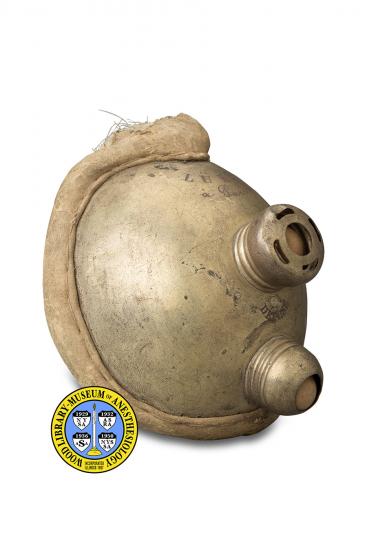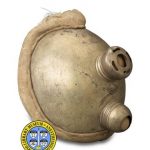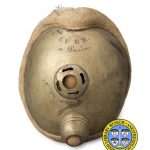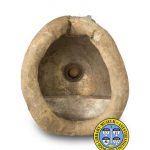Lüer Inhaler
The Parisian instrument maker, Maison Lüer was one of the first in the world to make anesthesia apparatus. It was a direct competitor to Charrière, and several of the designs made by these companies are very similar to one another. One of these look-alikes is a metal dome that has a small compartment to hold a sponge soaked with chloroform. This allowed the patient to breathe the vapor while preventing the sponge from touching the patient’s face. Contact with liquid chloroform could cause irritation of the skin and mucous membranes.
The valves on the top and side of the inhaler were probably designed to allow in fresh air when the patient inhaled, and to guide the patient’s exhaled carbon dioxide away. The soft rim of the mask is made of kidskin and is stuffed with animal hair. This ensured a close, comfortable fit. Unlike later rim covers made of rubber, this was sewn on, and could not be replaced or sterilized.
This inhaler was described by Bouisson in his 1850 textbook, Traité théorique et pratique de la méthode anesthésique appliquée a la chirurgie et aux différentes branches de l'art de guérir. (Theory and practice of anesthesia applied to surgery and war.) This title is in the WLM’s rare book collection. Compare the design of the Lüer Inhaler to that of the Sudeck Inhaler, introduced more than half a century later.
Catalog Record: Lüer Inhaler
Access Key: aleh
Accession No.: 2005-05-18-1
Title: Lüer [chloroform inhaler].
Corporate Author: Maison A. Lu¨er.
Title variation: Alt Title
Title: Lüer chloroform mask.
Title variation: Alt Title
Title: Masque inhalateur de chloroform Luer.
Title variation: Alt Title
Title: Luer’s chloroform mask inhaler.
Publisher: Paris : Lu¨er, [between 1848 and 1890?].
Physical Descript: 1 oronasal mask : metals, leather, hair, wood ; 10 x 9 x 7 cm.
Subject: Masks, Anesthesia.
Subject: Chloroform – administration & dosage.
Note Type: General
Notes: The early year in the date range for the possible year of manufacture is
based on the earliest publication in which the mask is found (Bouisson, 1850)
Also, Cazallaa dates the mask with the year 1848. The end date is based on
the lack of definitive references found for this mask after 1888 (Gaujot,
1867). The date range could change if documentation that indicates the dates
should be corrected is discovered.
Note Type: General
Notes: The title is based on the WLM common name of the object.
Note Type: Citation
Notes: Bause GS, Conlay LA. Treasures of the WLM. ASA Newsl. September,
2006;70(9):7-13. https://www.asahq.
org/For-Members/Publications-and-Research/Newsletter-Articles.
aspx?VolYear=2006. Accessed October 7, 2014.
Note Type: Citation
Notes: Bouisson EF. Traité théorique et pratique de la méthode anesthésique
appliquée a la chirurgie et aux différentes branches de l’art de guérir.
Paris: J.B. Baillière; 1850:122-123. https://archive.
org/details/traitthoriqueetp00boui. Accessed October 1, 2014. [Illustration
of the mask.]
Note Type: Citation
Notes: Cazalaa JB, Baker D, Cousin MT. Les Instruments d’Anesthesie et de
Reanimation : France, Allemagne et Royaume-Uni (1847-1970). Paris: Editions
Glyphe, 2005:31-32.
Note Type: Citation
Notes: Crash kit syringes. Quality Matters. November, 2012;21(11):1-2. https://www.
medicinesresources.nhs.uk/GetDocument.aspx?pageId=776889. Accessed October 7,
2014.
Note Type: Citation
Notes: Gaujot G, Spillmann E. Arsenal de la chirurgie contemporaine. Paris: J. B.
Baillie`re et Fils, 1867:26. https://archive.
org/details/arsenaldelachiru01gauj. Accessed October 1, 2014. [Possible
mention of this particular design.]
Note Type: Citation
Notes: Lüer Maison A. Catalogue Illustré des Instruments de Chirurgie]: Prix-Courant
Paris: Imprimeur E. Watelet; 1888:165. [The inhaler is included in Luer’s
1888 catalog, with an image of the mask inhaler. This catalog is held by the
Allen Memorial Medical Library at the Dittrick Medical History Center and
Museum, in the Cleveland Health Sciences Library at Case Western Reserve
University.]
Note Type: Citation
Notes: Sella A. Lüer’s syringe. Chemistry World website. https://www.rsc.
org/chemistryworld/2012/08/luer-syringe. Published August 28, 2012. Accessed
October 7, 2014.
Note Type: Physical Description
Notes: One mask chloroform inhaler; The measurements, 10 x 9 x 7 cm (height x width
x depth), were taken from the perspective e of a patient facing the mask as
though it is about to be placed on the face; The mask if anatomically shaped
to accommodate the curves of the nose and face and cover the nose and mouth;
On the outside of the mask are wood ball type inspiratory and expiratory
valves, possibly made of wood; The rim is padded with what seems to be coarse
animal hair and is made of very worn and aged leather (possibly kidskin) or
felt; Inside the lower portion of the mask, near the mouth and chin, is a
ledge or divider, meant to hold a chloroform soaked sponge; Markings on the
outside of the mask include, “LÜER [new line] a Paris.”, and “DÉPOSÉ”.
Note Type: Historical
Notes: Constructed inside the lower portion of this mask-inhaler is a small ledge,
or divider, that forms a receptacle in which a chloroform soaked sponge can
be placed. It allowed the patient to breathe the chloroform vapor that
evaporated from the sponge while preventing the sponge from touching the
patient’s face. When liquid chloroform had contact with skin or mucous
membranes it could cause uncomfortable irritation.
The Lüer Inhaler was created by an instrument maker better known for the
design of a very popular two-piece, glass and metal syringe. The company was
commonly known as Maison Lüer, and was founded in Paris by a Amatus Lüer
(1802-1883), a German cutler who moved to Paris in 1834 and apprenticed under
the famous instrument maker Joseph-Frédéric-Benoît Charrière (1803-1876). In
the late 1830s Lüer opened up his own successful cutlery. This inhaler may
have been designed by Lüer himself in the late 1940s. However, Luer’s
daughter, Jeanne, led in the design of the famous syringe. Jeanne Lüer joined
her father in the workshop during the 1860s. Eventually, Jeanne and her
husband, Hermann Wulfing, ran the business with Hermann handling managerial
and sales functions while Jeanne developed medical and surgical instruments
and managed the workshop.
Note Type: Publication
Notes: Wulfing-Luer HA. Aseptic syringe. US patent 772,450. October 18, 1904.
https://www.google.com/patents/US772450. Accessed October 7, 2014.




